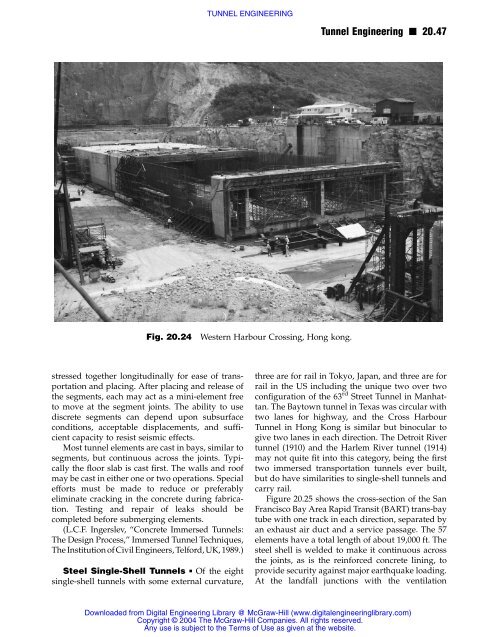TUNNEL ENGINEERING
TUNNEL ENGINEERING
TUNNEL ENGINEERING
You also want an ePaper? Increase the reach of your titles
YUMPU automatically turns print PDFs into web optimized ePapers that Google loves.
stressed together longitudinally for ease of transportation<br />
and placing. After placing and release of<br />
the segments, each may act as a mini-element free<br />
to move at the segment joints. The ability to use<br />
discrete segments can depend upon subsurface<br />
conditions, acceptable displacements, and sufficient<br />
capacity to resist seismic effects.<br />
Most tunnel elements are cast in bays, similar to<br />
segments, but continuous across the joints. Typically<br />
the floor slab is cast first. The walls and roof<br />
may be cast in either one or two operations. Special<br />
efforts must be made to reduce or preferably<br />
eliminate cracking in the concrete during fabrication.<br />
Testing and repair of leaks should be<br />
completed before submerging elements.<br />
(L.C.F. Ingerslev, “Concrete Immersed Tunnels:<br />
The Design Process,” Immersed Tunnel Techniques,<br />
The Institution of Civil Engineers, Telford, UK, 1989.)<br />
Steel Single-Shell Tunnels n Of the eight<br />
single-shell tunnels with some external curvature,<br />
<strong>TUNNEL</strong> <strong>ENGINEERING</strong><br />
Fig. 20.24 Western Harbour Crossing, Hong kong.<br />
Tunnel Engineering n 20.47<br />
three are for rail in Tokyo, Japan, and three are for<br />
rail in the US including the unique two over two<br />
configuration of the 63 rd Street Tunnel in Manhattan.<br />
The Baytown tunnel in Texas was circular with<br />
two lanes for highway, and the Cross Harbour<br />
Tunnel in Hong Kong is similar but binocular to<br />
give two lanes in each direction. The Detroit River<br />
tunnel (1910) and the Harlem River tunnel (1914)<br />
may not quite fit into this category, being the first<br />
two immersed transportation tunnels ever built,<br />
but do have similarities to single-shell tunnels and<br />
carry rail.<br />
Figure 20.25 shows the cross-section of the San<br />
Francisco Bay Area Rapid Transit (BART) trans-bay<br />
tube with one track in each direction, separated by<br />
an exhaust air duct and a service passage. The 57<br />
elements have a total length of about 19,000 ft. The<br />
steel shell is welded to make it continuous across<br />
the joints, as is the reinforced concrete lining, to<br />
provide security against major earthquake loading.<br />
At the landfall junctions with the ventilation<br />
Downloaded from Digital Engineering Library @ McGraw-Hill (www.digitalengineeringlibrary.com)<br />
Copyright © 2004 The McGraw-Hill Companies. All rights reserved.<br />
Any use is subject to the Terms of Use as given at the website.
















